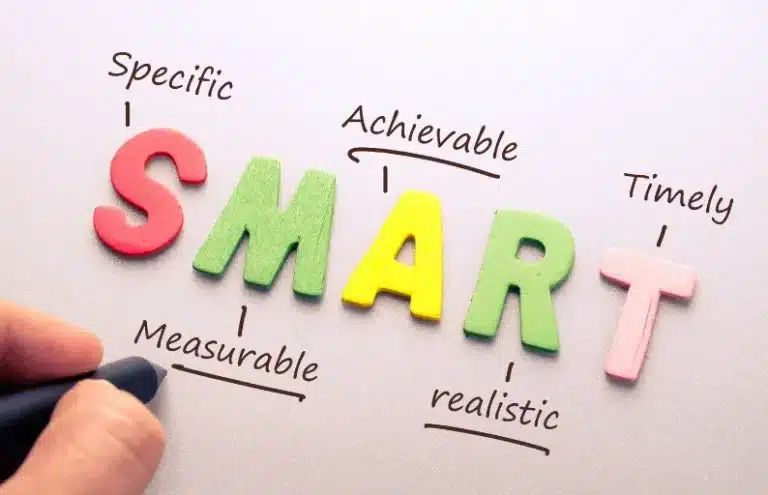Planning is essential. Not just in life, but when designing an eLearning training action. But what are learning objectives and why are they important? As you should know, it is in this first stage that the definition of the learning objectives we are going to meet must be carried out, so that the course can come to a successful conclusion. Both students, teachers and administrators must complete their training with the satisfaction of a job well done. A good approach to these will help you assess the performance of participants and the quality of your project.
In this post we will show you what are the requirements that must meet to achieve success online and we tell you what smart learning objectives are. Do not wait any longer and take note!
What are learning objectives

Learning objectives examples
On the one hand, with reference to learning objectives examples, if we are talking about a secondary education environment, an objective could be that at the end of the module, the student is able to identify and explain the main events of the French Revolution. On the other hand, if we are talking about a corporate training, the learning objective could be that at the end of the course, employees are able to apply the Scrum methodology in the management of their projects.
In each case, as we can see, the student learning objectives will be different, but always clear and precise and following the lesson plan objectives. Below we explain how to set and define them.
How to set the criteria for learning objectives

In order to know how to develop student learning objectives, the first thing to do is to align them with the needs of the learners or the context in which they will be applied, be it a profession, a subject, or a subject. To do this, it is advisable to follow the SMART method, what are known as smart learning objectives, an acronym for:
- Specific: objectives should be clear and well defined so that students really understand what is expected of them. For example, in the case of a programming course, if we set as an objective ‘to learn to program with Phyton at a basic level’ it will be more concrete and better than simply ‘to improve programming skills’. It is important, therefore, to establish this framework.
- Measurable: it is important to establish a scale to know if the objectives have been met. Measurable learning objectives are important for this. To do this, it is necessary to indicate the way in which an objective will or will not be considered achieved. Continuing with the previous example, we would specify that to meet the objective it will be necessary to ‘write a Python program that performs basic mathematical operations’. In this way it will be possible to measure progress.
- Achievable: learning objectives must also be realistic, i.e. they must be achievable given the resources and time available. As an example, we could state the objective as follows: ‘Master the basics of Python in one month’. In this way we set a time period, which is achievable. However, if we set ‘become an expert in programming in one week’ it will not be and will ultimately create frustration for the learner and the trainer.
- Relevant: learning objectives have to be aligned with the needs of the learner and the environment in which they will be applied. Thus, we will set the objective as: ‘learn Python for data analysis’, which is clearer for an analyst than simply defining it in this other way: ‘learn Python for game design’.
- Time-bound: time is key. We have to define a period of time for the learning objective to be met. It is not enough to leave it open. So we will mark: ‘complete an introductory Python course in four weeks’ so that the student can organise himself. Setting a clear time frame is necessary to make it easier to achieve them.
Essential components of learning objectives
- Audience: who is the target audience for the learning. Important for tailoring the training and therefore also the objectives.
- Action: what specific and observable action should they perform. It should be clear what we expect from the learners.
- Condition: in what context or under what circumstances the action will take place.
- Criterion: what is the acceptable level of performance. Where would be the bar to be taken into account in order to exceed an objective.
Differences between educational and business environments

- Educational environment: this refers to schools, universities and business schools where the focus is on the development of long-term theoretical and practical knowledge, with a focus on the holistic learning of the learner.
- Business environment: in this case, the objectives tend to focus on skills that can be applied immediately, so as to improve both job performance and the possible return on this investment in training. Practical application prevails over the acquisition of theoretical knowledge.
Types of learning objectives

Si buscas la máxima eficacia en tu formación online, has de tener en cuenta que los objetivos han de ser específicos, alcanzables, realistas, medibles y acotados en el tiempo. Además de estas características, podemos distinguir dos grupos claramente diferenciados según su nivel de concreción:
- General objectives: these refer to the competences to be acquired or developed by the participants during the course.
- Specific objectives: these derive from the previous ones, as they are the intermediate steps to overcome the general ones. In other words, they are the specific guidelines that each participant must fulfil in each thematic unit.
- Cognitive objectives: focus on the acquisition of knowledge and the development of critical thinking. They involve remembering, understanding, applying, analysing, evaluating and creating information. To define them appropriately, one can use Bloom's taxonomy (objectives), a model widely used in education that classifies learning into different levels of cognitive complexity. Example: ‘explain Darwin's theory of evolution’.
- Psychomotor objectives: these objectives are related to the development of motor or physical skills. They are usually applied in disciplines that require manual practice, such as the use of tools or the execution of procedures. An example would be: ‘learning to use a microscope correctly’.
- Affective objectives: these focus on the formation of attitudes, values and behaviours. They are linked to empathy, ethics and collaboration. An example: ‘develop an attitude of respect and tolerance in multicultural environments’.
Importance of learning objectives

Learning objectives play a key role in the planning and implementation of any educational or training programme. Their importance of learning objectives lies in the following aspects:
- Orientation and structure: objectives provide clear guidance on what is expected to be achieved, helping to organise content in a logical and progressive way.
- Assessment of learning: they allow for the measurement of students' progress and achievements, facilitating the identification of strengths and areas for improvement.
- Motivation and engagement: students have a better understanding of their progress and goals to be achieved, which fosters their interest and commitment to learning.
- Improved teaching: help teachers and trainers to design more effective teaching strategies aligned to the needs of learners.
How to measure learning objectives?

To evaluate whether learning objectives have been met, it is essential to use appropriate metrics and tools. In this sense, we recommend you read our article where we explain how to measure ROI in elearning and evaluate its effectiveness.
- Identify the competencies and behaviours you want your participants to acquire or develop.
- Take into account the conditions: by studying the training environment you will have all the information you need to execute the competences and obtain the necessary resources.
- Set performance levels: to do this, you have to define the performance values to be achieved by the participants with respect to a goal.
How to formulate measurable objectives for your course?
An objective can be translated into competences. That is, what is expected of each learner, taking into account his or her level of engagement and relationship with the environment. For this reason, three basic rules are established to achieve effective results, which are key when thinking about how to write measurable learning objectives:
- Focus on objective actions: set goals that have tangible parameters and concrete behaviours that you expect from your students. Use action verbs (apply, design, identify...) that can be quantitatively evaluated and help you to measure these goals. It is recommended to avoid the use of verbs that may create some kind of ambiguity, such as know, understand, know how...
- Describe competences and results: your learning objectives must specify the results, not the tasks that are going to be carried out during the course. In other words, you do not have to explain what the content of the training action is, but what the learners will achieve.
- Specify a single competence for each objective: this section should not go unnoticed, as it will allow you to know what skills each participant has acquired during the training.
As you have seen, knowing how to develop measurable learning objectives is essential to the success of your project.
Specific objectives of e-learning

And in the context of e-learning in general? Here the specific objectives of e-learning have key particularities that we are probably already familiar with if we are involved in this sector:
- Accessibility and flexibility: a specific objective of virtual education will be to allow learning at any time and from any place. This makes it easier for students to combine their training with other responsibilities, whether personal or professional.
- Personalisation: e-learning platforms can offer individualised learning, adapting to the different levels of knowledge and pace of learners. This has been taken to an even more advanced level, thanks to data analysis and artificial intelligence.
- Use of technology: virtual education and training integrates interactive tools, simulations and automated assessment to enhance the experience. Technologies such as virtual reality, gamification, allow learners to practice skills in simulated environments before applying them in real life.
- Interaction and collaboration: despite being a virtual modality, online training will also promote social integration and cooperative learning, objectives that it facilitates, using tools such as chat, forums, video calls and other collaborative activities. In this way, students will be able to share knowledge and experiences, enriching the learning process.
- Continuous assessment and monitoring: thanks to digital tools, it is possible to monitor the progress of each learner in detail. Data analysis allows teachers and course administrators to identify areas for improvement and adjust content to make learning more effective.
Defining e-learning objectives is essential to ensure that courses are effective, engaging and meet the expectations of learners and organisations.
This approach allows you to structure learning efficiently, achieving better results in any environment. How do you define learning objectives in your courses?
